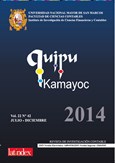ANALYSIS OF EDUCATIONAL REFORM IN ECUADOR
DOI:
https://doi.org/10.15381/quipu.v22i42.11062Keywords:
Educational reform, early childhood education, intercultural, institutions, educational qualityAbstract
The present article seeks to analyze the educational reform in Ecuador from the new institutions of the country, which constitutes the government of Econ. Rafael Correa Delgado with the new educational model that began in January 2010, after the complete restructuring of the Ministry of Education, whose objective was to ensure the path to early education in Ecuador with quality and warmth, strengthening the education authority, deconcentration articulated a system that encourages an approach with citizens and access to free education at all levels: primary, se-condary and higher, with some necessary conditions.An introduction is drawn from educational reform succeeded in 1983, which originates four years later, the “Education Law” or Law 127, published in Official Record 484 of May 3, 1983.This analysis also helps to demonstrate concrete results or social and educational progress that has generated educational reform within the internal and external environment, based on the perspective of before and after, and how through, its application has been made to strengthen the processes to improve the quality, re-levance, equity and efficiency of education in Ecuador.
Downloads
Downloads
Published
Issue
Section
License
Copyright (c) 2014 José Alberto Vásquez Flores, Víctor Alberto Betancourt Gonzaga, Gonzalo Junior Chávez Cruz, José Vicente Maza Iñiguez, Alexander Geovanny Herrera Freire, Gladys Narcisa Zúñiga Reyes

This work is licensed under a Creative Commons Attribution-NonCommercial-ShareAlike 4.0 International License.
AUTHORS RETAIN THEIR RIGHTS:
a. Authors retain their trade mark rights and patent, and also on any process or procedure described in the article.
b. Authors retain their right to share, copy, distribute, perform and publicly communicate their article (eg, to place their article in an institutional repository or publish it in a book), with an acknowledgment of its initial publication in Quipukamayoc .
c. Authors retain theirs right to make a subsequent publication of their work, to use the article or any part thereof (eg a compilation of his papers, lecture notes, thesis, or a book), always indicating the source of publication (the originator of the work, journal, volume, number and date).






